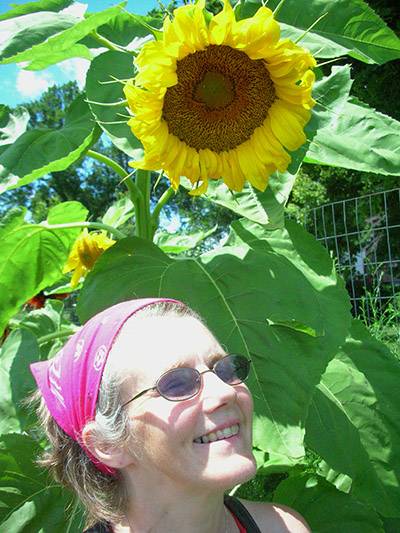 “I used to think, ‘I only have five tomatoes. What will a place like the Times Center do with five tomatoes?'” says Lisa Braddock, creator of Sunshine Harvest Sharing.
“I used to think, ‘I only have five tomatoes. What will a place like the Times Center do with five tomatoes?'” says Lisa Braddock, creator of Sunshine Harvest Sharing.
“But , then I realized that they could put my five tomatoes with someone else’s five and someone else’s squash and make soup.”
The food pantry and feeding program listings on Sunshine Harvest Sharing allow backyard gardeners to easily get their harvest to people in their community whose access to fresh produce is limited.
“Like most gardeners, I tend to overplant. You always think I’ll make sauce or salsa. But then when the tomatoes come on you have so much going on that you can’t use them all. You want to give them to people who can use them.”
Braddock isn’t alone in her quest to share her harvest with those in need. Since 1995, members of the Garden Writers Association have encouraged their readers and listeners to plant an extra row of produce each year and donate their surplus to local food banks, soup kitchens, and service organizations. The program, Plant A Row for the Hungry (PAR), caught on in many areas, but not all. More recently Ample Harvest attempted to link gardeners with food pantries.
Braddock became familiar with Ample Harvest through her job as WILL’s coordinator for CU Fit Families, where she met Cheryl Precious of the Eastern Illinois Foodbank. “I ended up interviewing Cheryl and she referred me to Ample Harvest, but I soon realized that not all of our local pantries were listed. Ample Harvest is a great website, but it relies on pantry staff and volunteers to register their pantry, so not all of a community’s pantries might be listed. Many pantries are small and many times those who operate them do not have internet access or email.”
Because of this, Braddock set out to create a site that included all the pantries and programs in her community. She contacted and surveyed them herself, at times by email but also by phone. “There’s still a gap with computer skills, so sometimes I would have to send the survey to someone outside of the pantry who had email. Sometimes, I would call or stop by in person. I remember showing up at a pantry and the woman there said to me, “Hi, honey, how can I help you? She was so sweet. How can you not want to help people like that?”
Through her survey, Braddock learned not only the times and days that produce could be dropped off, but also how the pantries and programs wanted the produce packaged, e.g. washed and/or in containers that don’t need to be returned. This information is included in the tips section of the site.
“These people are doing so much, I wanted already to make things easier for them, not create an additional burden,” says Braddock. In keeping with this philosophy Braddock also keeps in touch with the pantries and programs to see how things are going and updates the site as necessary, which is key in rural areas with small food pantries. “These pantries are often run by a very small team of volunteers, or even a single volunteer. If something happens to that person, the pantry may have to close.”
Since creating the listings for Champaign County, she has expanded the site to include Harrisburg, Illinois, and Moab, Utah. “These people all are, or were my neighbors,” she explains. Ultimately, Braddock wants to expand the site to include all of the 14 counties served by the Eastern Illinois Foodbank. I know there are gardeners out there who feel like I do. This way they can easily find a place that will use their produce to help people, and that’s the point. “Even if the Times Center just had my five tomatoes, those tomatoes would make five people very happy.”








